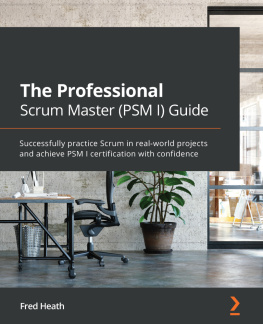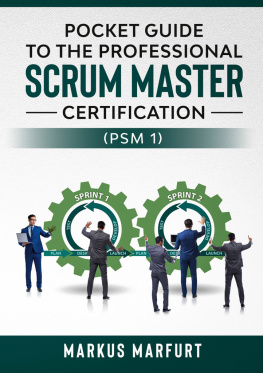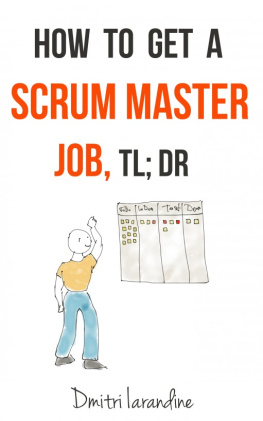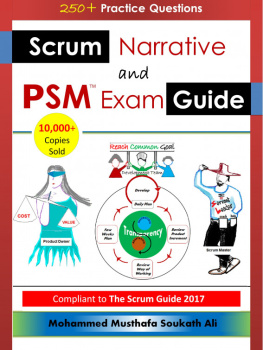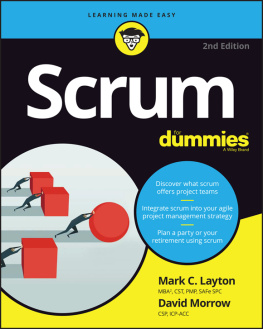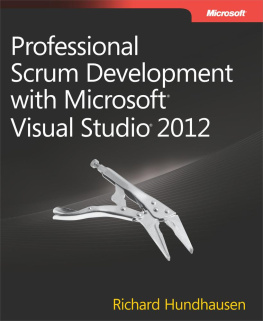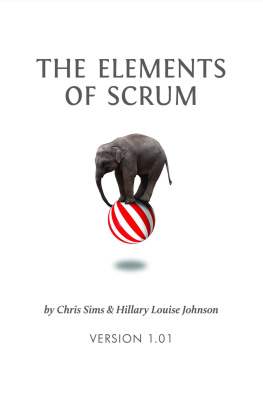The Professional Scrum Master (PSM I) Guide
Successfully practice Scrum in real-world projects and achieve PSM I certification with confidence
Fred Heath
BIRMINGHAMMUMBAI
The Professional Scrum Master (PSM I) Guide
Copyright 2021 Packt Publishing
All rights reserved. No part of this book may be reproduced, stored in a retrieval system, or transmitted in any form or by any means, without the prior written permission of the publisher, except in the case of brief quotations embedded in critical articles or reviews.
Every effort has been made in the preparation of this book to ensure the accuracy of the information presented. However, the information contained in this book is sold without warranty, either express or implied. Neither the author, nor Packt Publishing or its dealers and distributors, will be held liable for any damages caused or alleged to have been caused directly or indirectly by this book.
Packt Publishing has endeavored to provide trademark information about all of the companies and products mentioned in this book by the appropriate use of capitals. However, Packt Publishing cannot guarantee the accuracy of this information.
Group Product Manager: Kunal Chaudhari
Publishing Product Manager: Shweta Bairoliya
Senior Editor: Storm Mann
Content Development Editor: Nithya Sadanandan
Technical Editor: Gaurav Gala
Copy Editor: Safis Editing
Project Coordinator: Deeksha Thakkar
Proofreader: Safis Editing
Indexer: Vinayak Purushotham
Production Designer: Ponraj Dhandapani
First published: June 2021
Production reference: 1180621
Published by Packt Publishing Ltd.
Livery Place
35 Livery Street
Birmingham
B3 2PB, UK.
ISBN 978-1-80020-556-7
www.packt.com
To my wife, Julie, and my daughter, Sophia. They make it all worthwhile.
- Fred Heath
Contributors
About the author
Fred Heath is a senior software engineer with 24 years' experience. Fred has worked at every level of the software development lifecycle and has used a multitude of technologies, platforms, and programming languages. His professional interests include programming in Ruby and Elixir, behavior-driven development, and semantic analysis.
Fred holds B.Eng and M.Sc. degrees (Cardiff University) and is a Microsoft Certified Professional (SQL Server 2000), a certified Professional Scrum Master (PSM-I), and a certified Professional Agile Leader (PAL-I). He enjoys blogging about software development topics and is a frequent speaker at conferences and meetups.
Fred has also authored Managing Software Requirements the Agile Way (Packt, 2020).
About the reviewer
Tarun Gupta is a certified Scrum Master with around 14 years of experience in IT. He has several credentials, including PMI-ACP, PSM II, CSM, ASM, SAFe Agilist 4.5, and PMP.
He started his career as a QA engineer in the telecom domain after graduating with a master's degree in computer applications (MCA) from Pune University in 2007. He has helped teams to transition from Waterfall to Agile and has coached them to achieve maximum efficiency and the highest product value by successfully completing sprints.
Tarun believes that Scrum has some important values, such as focus, commitment, openness, respect, and courage, that can be adopted in life to be more productive and successful. He believes that any organization can be Agile if there is transparency, continuous improvement, continuous delivery, and adaptability.
Preface
The Scrum framework was conceived in the late 1980s to counteract the formal, rigid, and stagnating software development methodologies prevalent at the time. The Scrum framework was formalized in the mid-1990s and its founders, Jeff Sutherland and Ken Schwaber, were instrumental in the creation of the Agile Manifesto and the subsequent spread of the Agile development movement. Scrum quickly became the most popular Agile framework, with huge adoption in both small businesses and the enterprise world. Part of the popularity of Scrum is its adaptability. The Scrum Guide keeps getting updated every few years to reflect current thinking and practices. Scrum.org also offers an impressive array of Scrum-related resources and certifications, one of which we'll be addressing in this book.
This book aims to teach people new to, or inexperienced with, Scrum all about the Scrum framework from a practical as well as a theoretical perspective. The book consists of two parts. In the first five chapters, we will cover the Scrum fundamentals. The theory and principles of Scrum will be digested, before moving on to cover the Scrum Team, Events, and Artifacts. The second part will focus on more practical knowledge, by examining practices and methods used by Scrum Teams in the real world. We will learn how to plan and estimate in Scrum, how to monitor progress and deal with different situations within the Sprint, best practices for infrastructure and testing, and how to manage eventualities such as technical debt or remote working. Every chapter closes with a short quiz to reinforce the knowledge gained.

